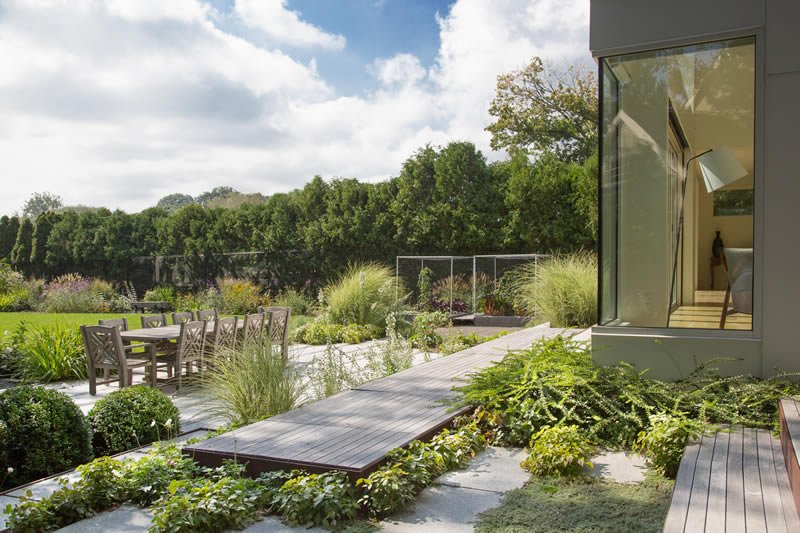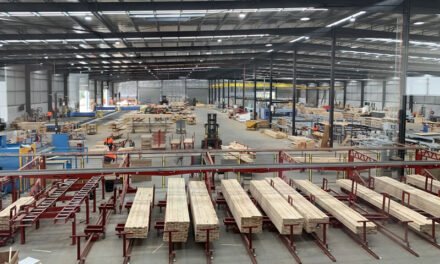The nation’s favourite outdoor structure is a brilliant place to show off the capability and beauty of timber. By Donyale Harrison.
A good backyard deck is as much a part of our traditional Australian lifestyle as barbecues and parliamentary backstabbing. But, unlike a snag or prime minister, it’s an investment that will last for decades.
As much a part of the house as of the garden, the deck is a transition zone that can cover a multitude of uses: casual alfresco seating and dining, an easy way of dealing with an unlevel site up against the house, even a holding structure for land that will one day be occupied by a future extension. It’s as home in commercial builds as in residential, over water as on land. Provided basic rules of materials choice, upkeep and standards are met, it’s an almost foolproof addition to a build.
Best of all, timber is the natural material of the deck. Whether tough Australian natives, recycled hardwoods, merbau from an accredited importer, treated softwoods or engineered timbers, there is an incredible range of looks and colours available that will suit almost any architectural and garden scheme and which mix well with other finishes and furnishings.
Depending on what your customer plans to build (and where), decks may or may not need development approval. Low structures away from boundaries are most likely to be exempt. Building Council of Australia regulations apply, just as for other timber commercial and residential structures, as do Australian Standards. It can be worthwhile for merchants to create information sheets that cover regulations to help customers make their choices, from posts in ground or not, to modifying designs to step down from the back door and lower deck height.
Designer tips
Too often, less thought is put into the deck than the rest of the house. But done well, it will be one of the most-used parts of the house, so it’s worth clients either spending more time on research or hiring a designer. Forming good relationships between timber suppliers and landscape designers benefits both and means each can refer clients on to a supplier they know will deliver top results.
Ian Barker is a landscape designer and builder working in Melbourne, who, with his team at Ian Barker Gardens, has created some of the most beautiful and practical decks in the city. His first rule of decks is size. “Some decks don’t even have room to walk around the table,” says Barker. “Ideally you should be looking for a minimum of five by six metres, and even bigger when it suits the dimensions of the home. In a garden, you want to feel that you have space around you, and a deck should feel relaxed and open, not cramped.”
Barker uses a range of visual tricks to make his decks feel more expansive. “In large spaces, we mix materials, adding a bit of stone or paving in among the timber,” says Barker. “We change levels, coming straight out from the house into a seating area and then stepping down into a dining area. We also add planting within the deck itself, which both softens the surfaces and integrates it into the broader garden.”
For small decks, there’s an equally clever range of design tricks to make them feel larger. “We limit the area covered by furniture and use pot clusters to fool the eye: three or five pots together – various styles and sizes or all the same. A bit of space between them gives a sense of generosity, without taking up loads of room.”
Bringing planting right up to the edge of the deck blurs the boundary and helps to increase the sense of size.
Not every supplier is able to provide design tips to customers, but at least make sure they consider the effect of different deck levels: coming straight out from the house provides a seamless indoor-outdoor transition, but can create a need for expensive engineering on a sloping site with a high drop-off at the deck edge. Stepping down from the house or changing level in the deck can be a much easier solution.
Making it last
Decks can represent a major investment, so it is important they are built to last. The timber will be exposed to sun and rain and may be in contact with the ground, which represents a termite risk. Michael Kennedy of Kennedy’s Timbers recommends starting with the best timber you can afford.
“Decking timbers that are going to be exposed to the elements should ideally be a Class 1 durability timber hardwood,” Kennedy says. “That means even if you do no maintenance at all, you’re going to get more than 25 years life from your deck.”
Kennedy recommends timber merchants encourage customers to provide as much information as possible about the conditions where the deck will be sited to ensure the timber chosen is right for the application (see Timber Choices, below). However, not everyone can afford Class 1 durability hardwoods. Clever choices of coatings can help cheaper timbers achieve a similar outcome at a lower cost, and will also extend the life of top quality boards.
Coatings such as stains, oils and paints are often spoken of interchangeably, but they all do different jobs. Stains, also labelled as coatings or sealants, are available in water-based and oil-based formulas. They can change or revitalise the colour of timbers and also provide UV protection, along with a number of specialist qualities such as mould protection and anti-slip. Oil-based stains also actively preserve the timber. Transparent stains need to be reapplied every year or two, but a darker stain can last up to five years depending on deck use and location.
Decking oils are like moisturiser for timber. They penetrate into the fibres of the wood and keep them plump, helping to preserve the boards against water, UV and wear damage. You will need to re-oil your deck every 6-18 months depending on local conditions.
Paint gives an opaque covering that protects against water, UV and mould. It’s a good option for old decks with surface flaws, but wears quickly and you lose the natural timber appearance.
While there is an enormous range of quality and technological sophistication in the products on the market, they all do two basic jobs: protect timber from water, and help to guard timber against UV damage. There are three basic rules that should be discussed with customers to help guide their choice. The first is that coatings are only useful if they are maintained. In difficult conditions, or for a customer unsure if they can commit to a maintenance schedule, spending more upfront on Class 1 durability hardwoods is a better investment.
The second is that preparation is key for all coatings. Timber must be dry, about 10-12% moisture for coatings to penetrate well. Many newly milled hardwoods, including merbau, are subject to tannin leaching when wet, which can stain the boards and clog the wood’s pores, preventing coatings from being absorbed evenly. Alkaline salt cleaners, such as Sikkens Cetol BL Tannin and Oil Remover, Intergrain PowerPrep or Organoil Wash-A-Way, can quickly remove tannins and will also leave the timber drier.
Thirdly, choosing between oils and stains and between water- and oil-based coatings is a commitment. Once you start with one type, it’s best to keep going with the same.
For high-quality timbers, oil is the traditional option. It highlights the natural qualities of the material and doesn’t require difficult preparation. “Oil stops the timber breaking down and keeps it in really good condition,” says Kennedy. “It’s not unusual to have a timber deck that will last more than 50 years if you use a Class 1 durability timber and you oil it. The modern oils that are out there are absolutely fantastic, whether from large or boutique manufacturers. And they’re quite easy to apply.
“Many decking manufacturers, ourselves included, now offer a pre-oiling service. In six, 12 or 18 months time, depending on exposure, you put another coat of oil over it. It makes it really easy for customers.”
Pre-oiling is a convenient value-add that does not require huge outlay at the manufacturer’s end, and allows immediate use after laying at the client’s end.
Northern climates with harsh sun and heavy rain require more frequent oiling. In gentler climates, such as Tasmania, longer gaps between reoilings are fine.
For less durable timbers, stains provide a barrier between the timber and moisture and UV, preventing raised surfaces, cracking and mould growth. Oil-based stains also penetrate the timber and help to actively preserve it. They allow a treated pine board to last much longer, and can give cheaper materials the appearance of more expensive ones. Water-based stains are faster to apply and easier to clean up, but may not be as durable in high-use areas or parts of the country with more extreme climates.
For customers who don’t want to pay for a high-quality board, but don’t want to do annual upkeep, composite boards require just general cleaning. For those who don’t mind the aesthetic compromise, they’re a reasonable alternative and there are good fire-resistant versions available.
Timber choices
Maintenance schedules are just one part of the information required when guiding customers to make appropriate decking material choices. The more detail a merchant or designer can gather, the more satisfactory a solution can be recommended.
Kennedy says the risk of using the wrong timber isn’t just for the current job, it can impact on how timber is perceived for all future jobs, especially with commercial builders and councils.
“Too often we see people ‘doing a deck’,” he says, “and they don’t use the right product for that application. Then they say timber’s no good in that application. Yet timber’s perfect for it, they just made the wrong choice. One of our local councils specified one deck as unseasoned Class 2 durability timber and it didn’t perform. They should have used a different product.
“Of course, we’ve got good examples, too. Brisbane City council have just done the Shorncliffe Pier and they did a great job on the specification: perfect choice of timbers: well-seasoned, high durability, there’s no maintenance on it, and they got the right surface texture on it for an anti-slip deck. They’ve done their homework on it and they’ve got a really good outcome.”
Starting questions include where the deck will be constructed. What part of Australia is it in? Is it over water? Under shelter? Will it be exposed to sun all day? Is the area shady? Is it a damp or arid site?
“Determining the area that you’re going to be putting the deck into will then determine what species will perform there to the optimum,” says Kennedy.
“If you have an area that’s going to get very moist and wet and it’s in a gully, you’d choose a timber like tallowwood, which is very good in those applications. We need to choose the right timber for the right application, rather than just having ‘timber decking’. It’s a bit like buying a car. You’d ask ‘What are you going to do? Do you need a 4WD? A ute? A people mover?’ No-one just sells ‘a car’. Same with a deck. Tell us about the circumstances: is there kilonewton loading on it? Is there pedestrian traffic? Would you rather no maintenance on it over time or are you going to maintain it? The more you can understand that, the better the solution can be for the client.”
Budget is a necessary part of the choice equation. There will always be a range of price points for building a deck and it’s important that all are catered for with fit-for-purpose product. Imported hardwoods are still popular, especially merbau for its reasonably priced strength, and treated pine holds a strong place in the market thanks to its price point and ease of installation.
Make sure the right treatment has been applied for the end use. A minimum H3 treatment is needed for boards not in contact with the ground. This class will cope with periodic moderate wetting and leaching. For posts and other outside, in-ground structural applications, a minimum of H4 is required. Higher hazard classes cope better with extremes of weather, damp soil and termite risk. Well-maintained stains can add considerably to the durability of pine, as well as the colour range.
Finally, looks matter. The beauty of timber is the number one reason behind its choice and different widths and profiles will give different results. Boards are commonly available in widths from about 65mm to 140mm or more for special orders and these different sizes create very different rhythms in the appearance of the deck. Most residential boards are cut to about 20mm, with commercial boards double or triple this to deal with the increased foot traffic.
Profiles include domed – a slight curve that allows water to run off quickly; flat – a plain board that’s easy to fix; and secret fix, which has a hidden recess in the sides for screwing that won’t show on the surface.
Added options include safety measures, such as anti-slip and fire-resistance. As with durability, these can come as integral qualities of the board, or be added through coatings and treatment.
Major brands including Sikkens and Intergrain supply non-slip products that have been well researched for use on timber.
As a timber man, Kennedy recommends choosing boards with the qualities you want if your budget suits. “If you want an anti-slip surface, you can do it one of two ways,” he says. “A sawn finish will give you an anti-slip of R11 [meets the Australian Standard]. Or you can do a textured finish, like a brush finish, which will enhance the slip resistance. Anti-slip coatings tend to wear off with use, so you’re better off getting timber that is anti-slip naturally.”
For fire resistance, high-density timbers such as blackbutt, spotted gum, merbau, and turpentine have good natural fire resistance. For less dense decking, a wide range of coatings can lower the risk.
Points of attachment
The decking screw is a classic construction solution: reasonable cost, easy to install, provides a long-lasting result that, unlike nails, isn’t prone to shifting.
For landscapers doing regular installations, attachments such as the Quick Drive decking system from Simpson Strong-Tie will speed up the job. For less rugged applications, and particularly for the home builder, it can be worthwhile looking at a deck fastening system. There are multiple good brands on the market, and they fulfil several tasks in one solution: a firm attachment, even spacing, and concealed attachment points.
Modular decking is also available, in both timber and composite materials. Panels of decking attach to sub frames using the product’s preferred system (usually screws or clips). These products are much easier to install, and it’s also easy to replace damaged sections, though there also is a more limited range of material and colour choices than timber boards allow. They can be treated just as their board equivalent (or left untreated for composites), so maintenance doesn’t require any special techniques.
All these options and choices can be a bit overwhelming for the client, so the easier suppliers can make the process, the more reassured the client will be. Arranging your product offering in tables that show which timbers, fixings and coatings will suit which conditions can help to speed up sales.
One important thing to keep in mind is that decking is essentially outdoor flooring. All the factors that can compromise flooring are in play for decking, but under less controllable climate conditions. For best results, make sure there is decent airflow under the deck and that any concrete slab below is sloped to allow for water runoff. The undersides of boards are tough and resilient, but prolonged moisture exposure can cause mould damage and decrease the deck’s lifespan.
Work to find appropriate solutions, and you’ll create a repeat client – and retain timber’s reputation as the best solution for one heck of a deck.
For more details, visit www.landscape.net.au, www.kennedystimbers.com.au, tenaru.com.au/product, www.intergrain.com.au and www.organoil.com.au
Image: This capacious deck by Ian Barker Gardens links the house to a large landscaped garden.












